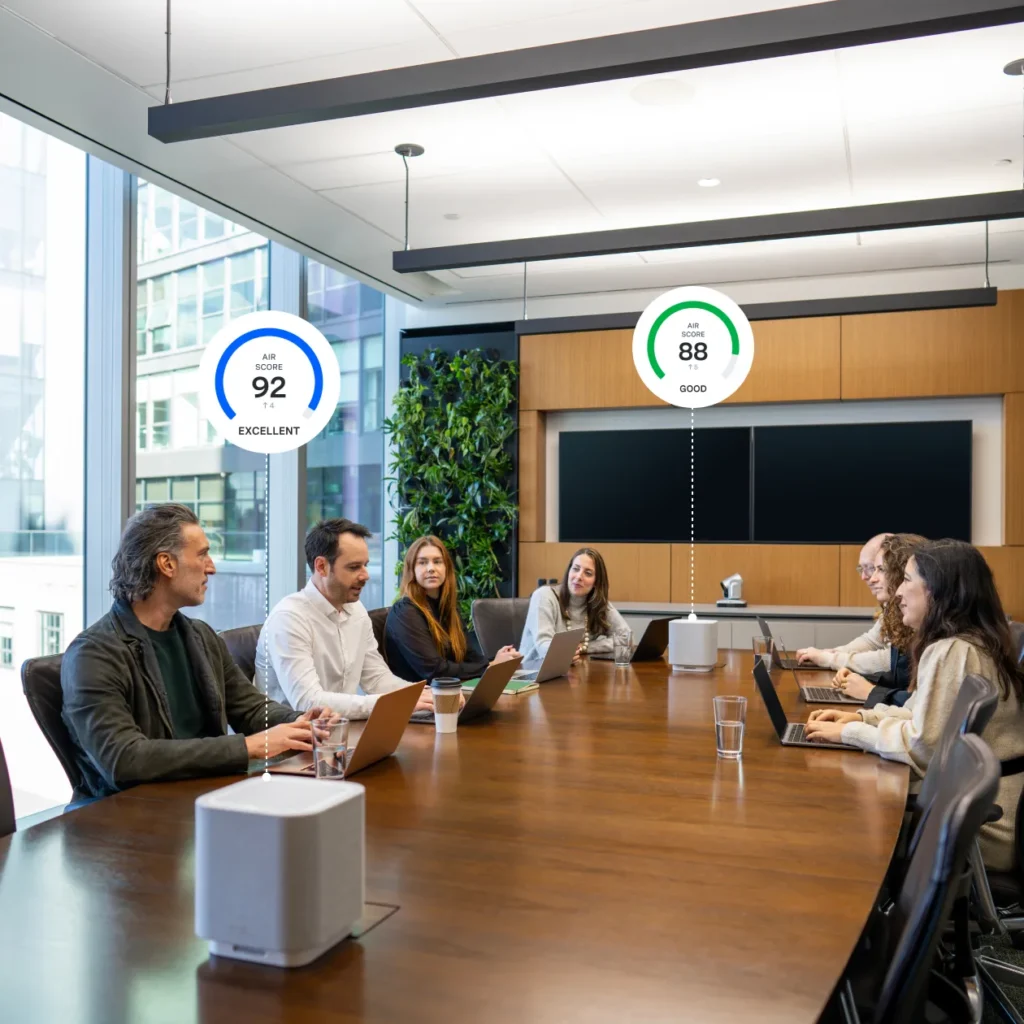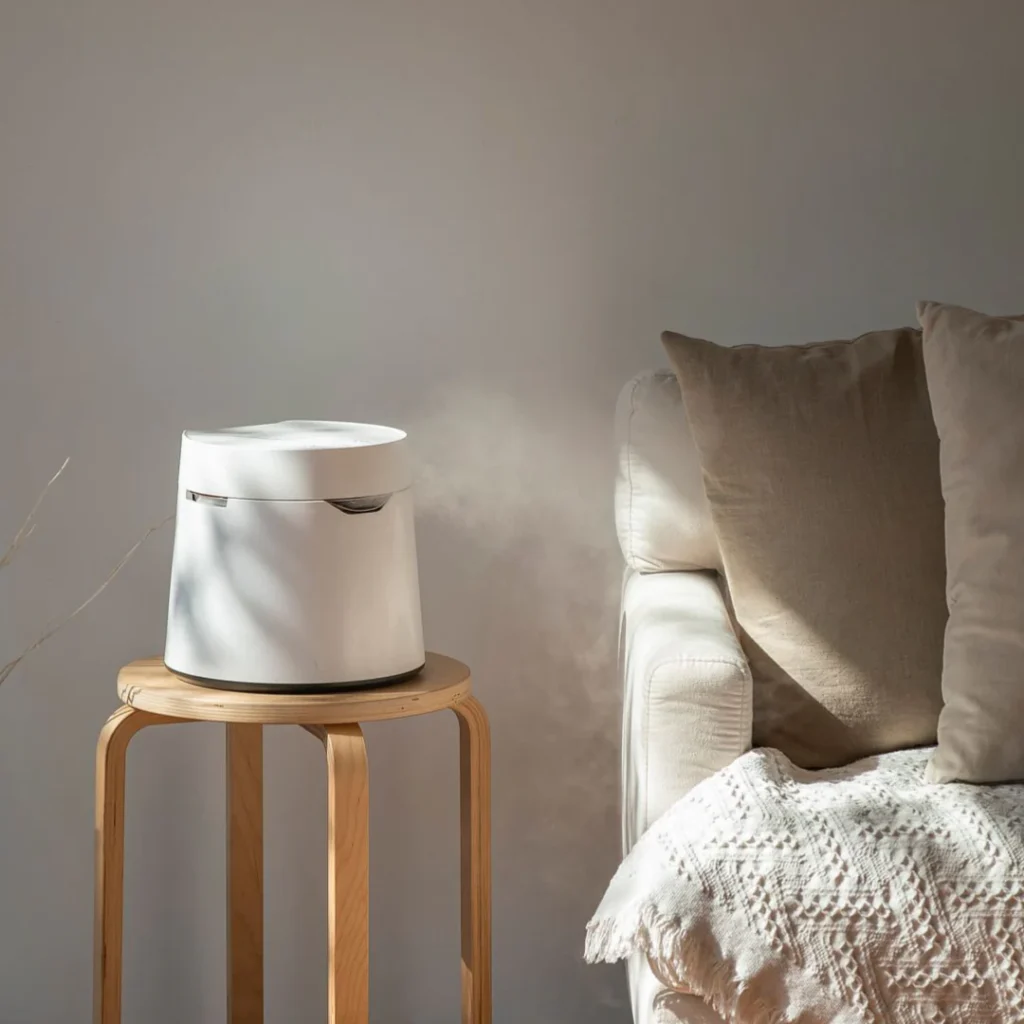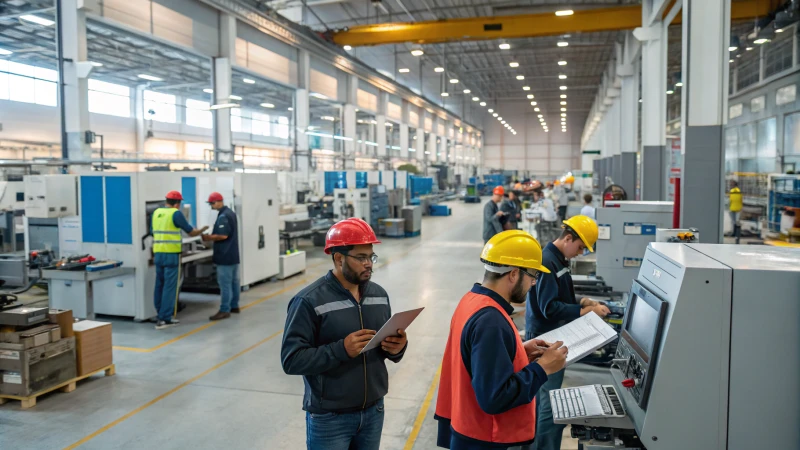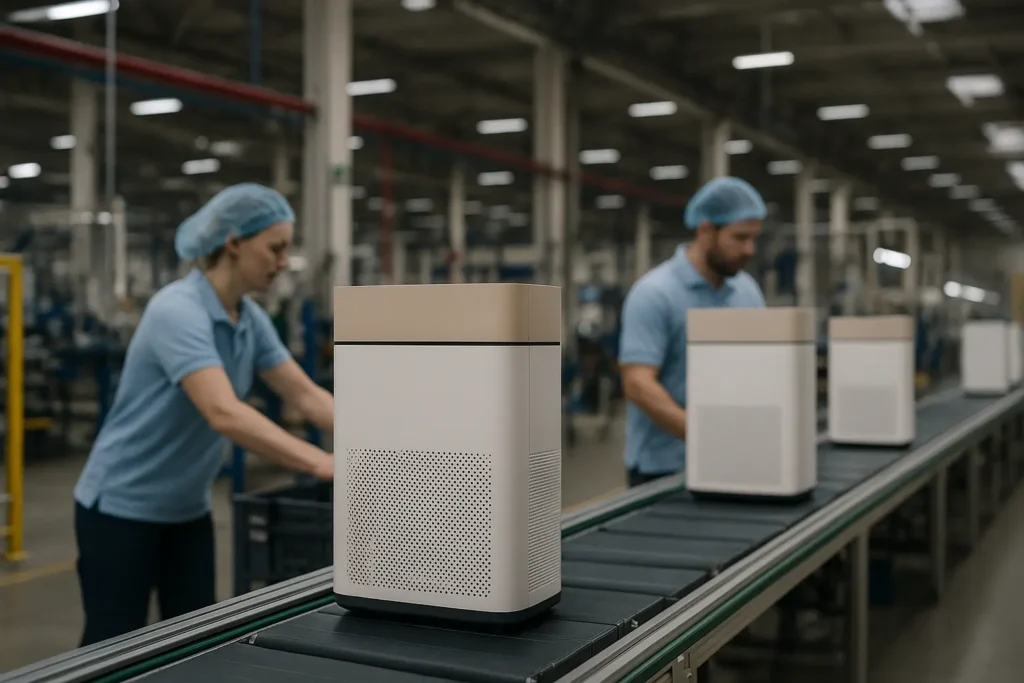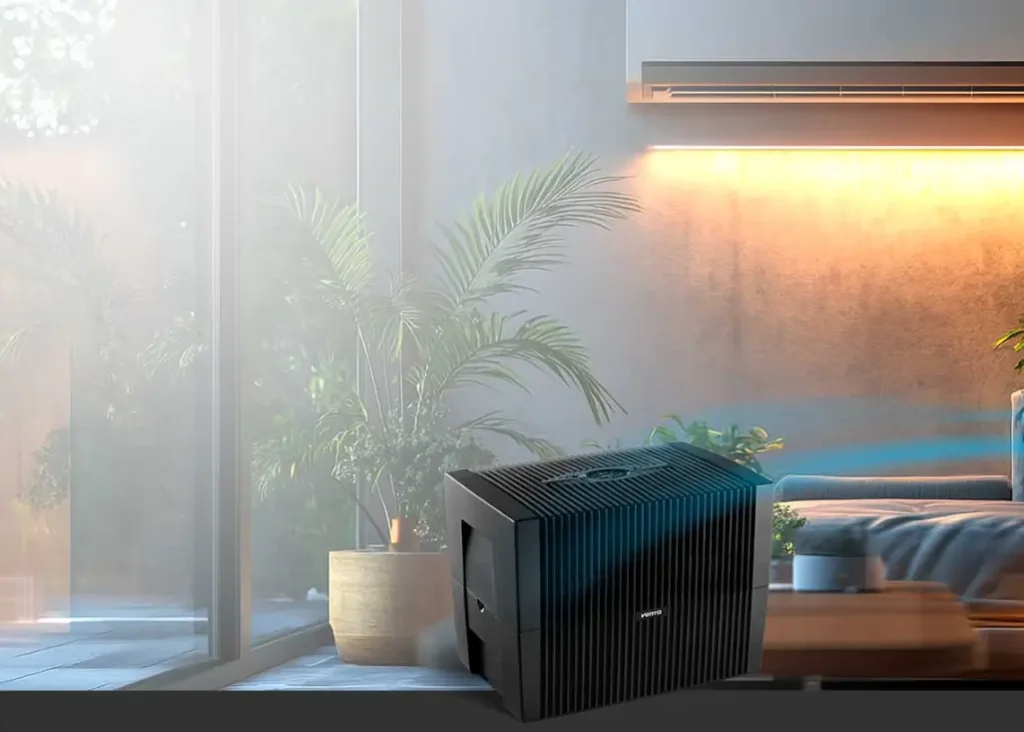
Avez-vous déjà pensé à l'air que vous respirez chez vous ? De plus en plus sensibilisés à la qualité de l'air et à la santé, de plus en plus d'Américains se tournent vers les purificateurs d'air domestiques pour s'assurer que leurs espaces de vie sont sûrs et propres.
Le marché américain des purificateurs d'air domestiques devrait atteindre $6,7 milliards d'ici 2032, avec un taux de croissance annuel composé (TCAC) de 6,6% entre 2022 et 2032.
Le marché américain des purificateurs d'air domestiques est le plus important au monde. Il est évalué à plusieurs milliards de dollars et devrait connaître une croissance significative en raison des préoccupations sanitaires et de l'innovation dans des segments de niche.
Mais les chiffres ne racontent qu'une partie de l'histoire. Nous allons nous pencher plus avant sur les véritables moteurs de ce marché dynamique et découvrir les tendances qui pourraient façonner son avenir.
Les États-Unis constituent le plus grand marché mondial pour les purificateurs d'air domestiques.Vrai
Le marché américain est le plus important au monde en termes de taille et de potentiel de croissance, en raison des préoccupations en matière de santé.
Quels sont les moteurs de la croissance du marché américain des purificateurs d'air ?
Le marché américain des purificateurs d'air est en plein essor, sous l'impulsion des défis environnementaux et des consommateurs soucieux de leur santé.
La croissance du marché américain des purificateurs d'air est stimulée par l'augmentation de la pollution, les avancées technologiques et les innovations sur les marchés de niche, ainsi que par une sensibilisation accrue aux questions de santé et d'environnement.

Préoccupations environnementales et sanitaires
Ces dernières années, des facteurs tels que incendies de forêt1 et l'augmentation des niveaux de pollution ont accentué le besoin d'un air intérieur plus propre, ce qui rend les purificateurs d'air essentiels. La pandémie de COVID-19 a renforcé cette prise de conscience, de nombreuses personnes cherchant à améliorer leur environnement domestique pour préserver leur santé. Cette tendance devrait se poursuivre à mesure que le public devient plus soucieux de sa santé.
Avancées technologiques historiques
Les États-Unis s'enorgueillissent d'une riche histoire dans le domaine des technologies de purification de l'air, avec HEPA développés à l'origine par l'armée. Cette histoire constitue une base solide pour la poursuite de l'innovation et la confiance des consommateurs. Le marché voit l'introduction régulière de technologies de pointe conçues pour répondre à des défis environnementaux spécifiques.
Politiques et soutien du gouvernement
Les politiques gouvernementales de soutien visant à améliorer la qualité de l'air jouent également un rôle essentiel. Les réglementations et les subventions encouragent les fabricants et les consommateurs à adopter des purificateurs d'air. Par exemple, les incitations gouvernementales en faveur des appareils à haut rendement énergétique incluent souvent des purificateurs d'air avancés.
Innovations sur les marchés de niche
Les marchés de niche tels que les purificateurs d'air pour animaux de compagnie, les purificateurs d'air pour bébés et les purificateurs d'air pour voitures se développent rapidement. Ces produits spécialisés répondent aux besoins uniques des consommateurs, ce qui stimule la croissance globale du marché. Les entrepreneurs qui réussissent dans ces domaines attribuent souvent leur succès à l'exploitation de segments mal desservis, ce qui offre un potentiel de croissance substantiel.
Partenariats stratégiques
Les partenariats avec des fabricants établis comme Hisoair peuvent fournir des ressources essentielles pour le lancement de produits innovants. Ces collaborations permettent aux entrepreneurs de tirer parti de l'expertise et de l'infrastructure existantes, ce qui réduit considérablement les délais de mise sur le marché et améliore la qualité des produits.
La croissance du marché américain des purificateurs d'air est stimulée par les incendies de forêt.Vrai
Les incendies de forêt augmentent la pollution, ce qui stimule la demande de purificateurs d'air.
Les politiques gouvernementales freinent la croissance du marché américain des purificateurs d'air.Faux
Les politiques de soutien et les subventions encouragent la croissance du marché.
Comment les marchés de niche améliorent-ils les opportunités dans le secteur des purificateurs d'air ?
Les marchés de niche de l'industrie des purificateurs d'air révèlent un potentiel inexploité et stimulent l'innovation et la spécialisation.
Les marchés de niche améliorent les opportunités en répondant aux besoins spécifiques des consommateurs, en encourageant l'innovation et en permettant aux entreprises de différencier efficacement leurs produits.

Comprendre les marchés de niche dans l'industrie des purificateurs d'air
Dans le vaste monde des purificateurs d'air, marchés de niche2 sont apparus comme de puissants vecteurs de croissance. Ces marchés se concentrent sur des segments spécialisés tels que les purificateurs d'air pour animaux de compagnie, qui s'adressent aux propriétaires d'animaux préoccupés par les squames et les allergènes. De même, les purificateurs d'air pour bébés s'adressent aux parents désireux de protéger leurs enfants des polluants nocifs.
Principaux facteurs de croissance des marchés de niche
Plusieurs facteurs contribuent à l'essor des marchés de niche dans le secteur des purificateurs d'air :
- Préoccupations en matière de santé: De plus en plus sensibilisés à la qualité de l'air, les consommateurs sont plus enclins à acheter des produits qui répondent à des problèmes de santé spécifiques.
- Progrès technologiques: Des innovations telles que HEPA Les filtres et l'intégration intelligente des technologies permettent aux fabricants de créer des solutions sur mesure pour répondre à des besoins divers.
- Appui réglementaire: Les politiques gouvernementales encourageant l'assainissement de l'air soutiennent la demande de produits spécialisés.
Le rôle de l'innovation et de la personnalisation
Les marchés de niche se développent grâce à la personnalisation et à l'innovation. Par exemple, les purificateurs d'air pour voiture ont gagné en popularité parmi les navetteurs qui souhaitent s'assurer d'un air pur lors de leurs déplacements. Ces appareils sont souvent équipés de fonctions telles que des ionisateurs et des modèles portables, ce qui montre comment les progrès technologiques répondent aux besoins spécifiques des modes de vie.
| Marché de niche | Consommateur cible | Caractéristiques uniques |
|---|---|---|
| Purificateur d'air pour animaux de compagnie | Propriétaires d'animaux | Filtre les squames d'animaux et les allergènes |
| Purificateur d'air pour bébé | Les parents | Fonctionnement silencieux, matériaux sûrs |
| Purificateur d'air pour voiture | Les navetteurs | Conception compacte et portable |
Les partenariats stratégiques, catalyseurs de réussite
Pour les entrepreneurs qui se lancent dans ces segments de niche, les partenariats stratégiques avec des fabricants tels que Hisoair peuvent s'avérer cruciaux. Les collaborations peuvent faciliter le développement de produits innovants qui s'alignent sur les demandes du marché, garantissant un avantage concurrentiel dans ce secteur en évolution rapide. En outre, les partenariats donnent accès à des technologies et à des connaissances de pointe, ce qui permet aux entreprises de se développer efficacement.
Il est essentiel de comprendre cette dynamique pour quiconque souhaite tirer parti des opportunités croissantes dans le secteur des purificateurs d'air. Qu'il s'agisse de répondre aux préoccupations spécifiques des consommateurs ou de tirer parti d'alliances stratégiques, les marchés de niche offrent une voie vers une croissance et une rentabilité durables.
Les marchés de niche des purificateurs d'air ciblent les besoins spécifiques des consommateurs.Vrai
Les marchés de niche se concentrent sur des segments spécialisés tels que les purificateurs d'air pour animaux domestiques et pour bébés.
Tous les purificateurs d'air sont conçus pour un usage domestique général.Faux
Certains purificateurs d'air sont conçus pour des besoins spécifiques, comme les voitures ou les animaux domestiques.
Quel est le rôle de la technologie dans l'évolution des purificateurs d'air ?
La technologie révolutionne les purificateurs d'air, les rendant plus efficaces et plus conviviaux.
Les progrès technologiques ont transformé les purificateurs d'air en améliorant l'efficacité de la filtration, en intégrant des fonctions intelligentes et en élargissant les domaines d'application, tels que les modèles portables et les modèles pour voitures.
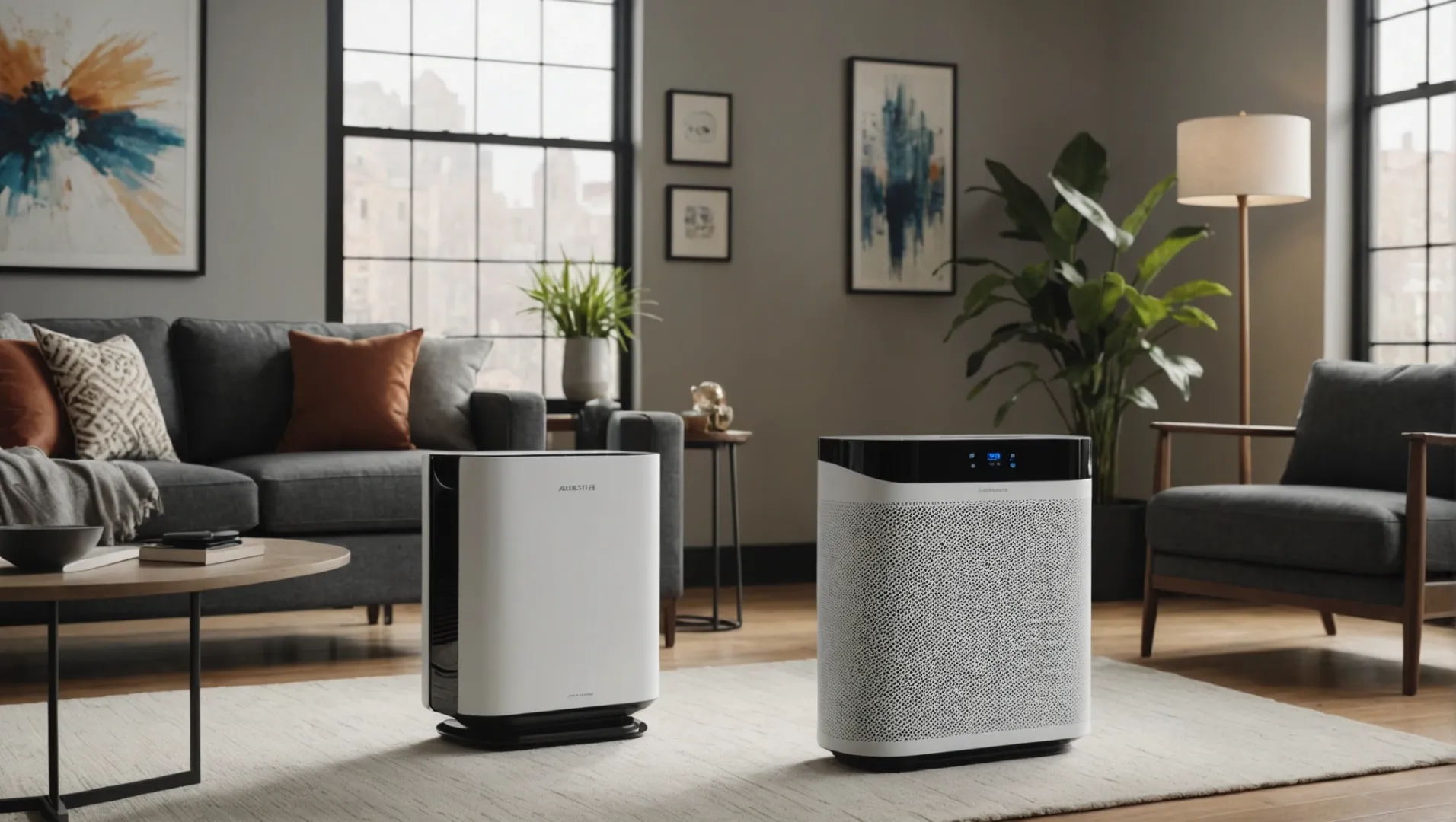
De HEPA Des filtres à la filtration avancée à plusieurs niveaux
Les purificateurs d'air ont d'abord pris de l'importance avec l'adoption de la technologie de l'air. HEPA (High-Efficiency Particulate Air), une technologie développée par l'armée américaine. HEPA restent une pierre angulaire, capturant efficacement des particules aussi petites que 0,3 micron. Toutefois, l'évolution technologique a permis d'introduire des systèmes de filtration à plusieurs niveaux qui combinent HEPA avec du charbon actif, de la lumière UV-C et de l'ionisation pour s'attaquer à une plus large gamme de polluants, y compris les virus, les COV (composés organiques volatils) et les odeurs.
Fonctionnalités et connectivité intelligentes
L'intégration de IdO (Internet des objets) a conduit au développement de purificateurs d'air intelligents qui peuvent se connecter aux réseaux domestiques. Ces appareils offrent un contrôle à distance via des applications pour smartphone, ce qui permet aux utilisateurs de surveiller la qualité de l'air en temps réel et d'ajuster les paramètres depuis n'importe où. En outre, les capteurs intelligents peuvent ajuster automatiquement les niveaux de purification en fonction des niveaux de polluants détectés, optimisant ainsi la consommation d'énergie et garantissant une qualité de l'air optimale.
Purificateurs portables et spécialisés
Les progrès technologiques ont permis la création de purificateurs d'air portables et spécialisés. Des modèles compacts sont désormais disponibles pour une utilisation en voiture ou en voyage, ce qui permet de résoudre les problèmes de qualité de l'air en déplacement. En outre, des produits de niche tels que les purificateurs destinés aux animaux domestiques ou aux bébés répondent à des besoins spécifiques, montrant ainsi que la technologie permet de différencier les marchés.
Perspectives d'avenir : AI et l'apprentissage automatique
L'avenir, AI (intelligence artificielle) et l'apprentissage automatique sont sur le point de transformer davantage la technologie de purification de l'air. Ces systèmes pourraient prédire les tendances en matière de pollution, offrir des solutions de purification personnalisées et améliorer l'efficacité des appareils. À mesure que ces technologies arrivent à maturité, elles promettent de rendre les purificateurs d'air encore plus indispensables dans notre vie quotidienne.
Le rôle de la technologie dans l'industrie des purificateurs d'air est indéniable. Les innovations qui voient le jour ne se contentent pas d'améliorer la fonctionnalité des produits, elles créent également de nouveaux débouchés pour les entrepreneurs qui cherchent à tirer parti de ce secteur en pleine croissance. Pour ceux qui souhaitent explorer plus avant ces avancées, un coup d'œil à AI applications dans le domaine de la purification de l'air3 ou la compréhension avantages de la filtration en plusieurs étapes4 pourrait offrir des informations plus approfondies.
Les filtres HEPA capturent des particules aussi petites que 0,3 micron.Vrai
Les filtres HEPA sont conçus pour capturer les particules jusqu'à 0,3 micron.
L'IA ne peut pas prédire les tendances de la pollution dans les purificateurs d'air.Faux
L'IA est développée pour prédire les tendances de la pollution et optimiser les purificateurs.
Pourquoi le partenariat stratégique est-il la clé du succès dans ce secteur ?
Dans un secteur concurrentiel comme celui des purificateurs d'air, les partenariats stratégiques sont essentiels à l'innovation et à la pénétration du marché.
Les partenariats stratégiques dans le secteur des purificateurs d'air permettent aux entreprises de tirer parti de leurs forces complémentaires, d'accéder à de nouveaux marchés et de favoriser l'innovation, ce qui est essentiel pour se démarquer sur un marché encombré.

Tirer parti des atouts complémentaires
Dans le secteur des purificateurs d'air, les collaborations impliquent souvent de combiner des compétences et des ressources qui ne sont pas disponibles au sein d'une seule entreprise. Par exemple, une startup technologique dotée d'une technologie innovante HEPA les concepteurs de filtres peuvent s'associer à un fabricant établi tel que Hisoair5 pour garantir une production de qualité. Ces alliances permettent aux entreprises de tirer parti de leurs points forts respectifs, améliorant ainsi leur offre de produits et renforçant leur compétitivité sur le marché.
Élargir la portée du marché
Les partenariats stratégiques peuvent également faciliter l'entrée sur de nouveaux marchés géographiques. Par exemple, les entreprises de purification de l'air basées aux États-Unis peuvent s'associer à des distributeurs internationaux pour exploiter la demande croissante à l'étranger, en particulier dans les régions touchées par la pollution et la mauvaise qualité de l'air. En collaborant avec des entités locales, les entreprises obtiennent des informations précieuses sur les préférences des consommateurs et les environnements réglementaires, ce qui est essentiel pour une expansion réussie.
Favoriser l'innovation et le développement de niches
L'innovation est essentielle sur le marché des purificateurs d'air, où des segments de niche tels que les purificateurs d'air pour animaux de compagnie et les modèles portables émergent rapidement. En s'associant à des entreprises technologiques ou à des établissements universitaires, les entreprises peuvent mettre au point de nouvelles caractéristiques de produits et améliorer les technologies existantes. Les partenariats axés sur la recherche et le développement (R&D) peuvent déboucher sur des solutions de pointe répondant aux besoins spécifiques des consommateurs, ce qui permet à l'entreprise de se démarquer de ses concurrents.
Relever les défis réglementaires
L'industrie des purificateurs d'air est soumise à des réglementations strictes visant à garantir la sécurité des consommateurs et l'efficacité des produits. La formation d'alliances avec des experts juridiques ou des organisations familières avec les paysages réglementaires peut aider les entreprises à naviguer efficacement dans les exigences de conformité complexes. Cela permet non seulement d'atténuer les risques, mais aussi d'accélérer la mise sur le marché de nouveaux produits.
Étude de cas : Le modèle de collaboration de Hisoair
Prenons le cas d'Hisoair, qui s'est engagée avec succès dans des partenariats stratégiques afin d'améliorer sa gamme de produits et sa présence sur le marché. En collaborant avec différentes parties prenantes - des fournisseurs aux détaillants - Hisoair a réussi à créer un portefeuille diversifié qui répond aux différents besoins des consommateurs. Un tel modèle souligne l'importance des alliances stratégiques pour parvenir à une croissance durable et à l'innovation dans l'industrie.
Les partenariats stratégiques augmentent la portée du marché des purificateurs d'air.Vrai
Les partenariats aident les entreprises à pénétrer de nouveaux marchés géographiques et à se développer.
Hisoair évite les partenariats stratégiques pour garder le contrôle.Faux
Hisoair s'engage dans des partenariats afin d'améliorer ses gammes de produits et sa présence sur le marché.
Conclusion
Le marché américain des purificateurs d'air domestiques est promis à une croissance continue, sous l'effet des préoccupations sanitaires et de l'innovation. Pour réussir, il est essentiel de se concentrer sur les créneaux et les partenariats stratégiques.
-
Découvrez comment les incendies de forêt détériorent la qualité de l'air dans tout le pays.. : Les incendies de forêt libèrent dans l'atmosphère de grandes quantités de dioxyde de carbone, de carbone noir, de carbone brun et de précurseurs de l'ozone. Ces émissions affectent la radia>on, les nuages ... ↩
-
Découvrez les segments spécialisés qui stimulent l'innovation dans le domaine des purificateurs d'air : Le segment vertical de l'industrie dans le rapport sur le marché mondial des purificateurs d'air industriels comprend l'alimentation et les boissons, le traitement des métaux, les produits pharmaceutiques, l'agriculture, l'énergie ... ↩
-
Découvrez comment l'IA optimise les performances des purificateurs d'air.. : Le purificateur contiendra quatre capteurs avancés intégrés pour détecter la poussière, les COV, la température et l'humidité. En outre, le système d'intelligence artificielle peut se connecter à l'internet ... ↩
-
En savoir plus sur l'efficacité de la filtration et l'élimination des polluants.. : L'accent étant mis sur la réduction des agents pathogènes en suspension dans l'air, l'amélioration de la qualité de l'air intérieur n'est possible qu'en combinant les meilleures technologies de purification de l'air. ↩
-
Découvrez comment un partenariat avec Hisoair améliore les capacités de production.. : Nous nous engageons à améliorer le bien-être grâce à une qualité d'air supérieure, en veillant à ce que chaque client bénéficie de notre soutien dévoué et de notre excellence en matière d'ingénierie. ↩


